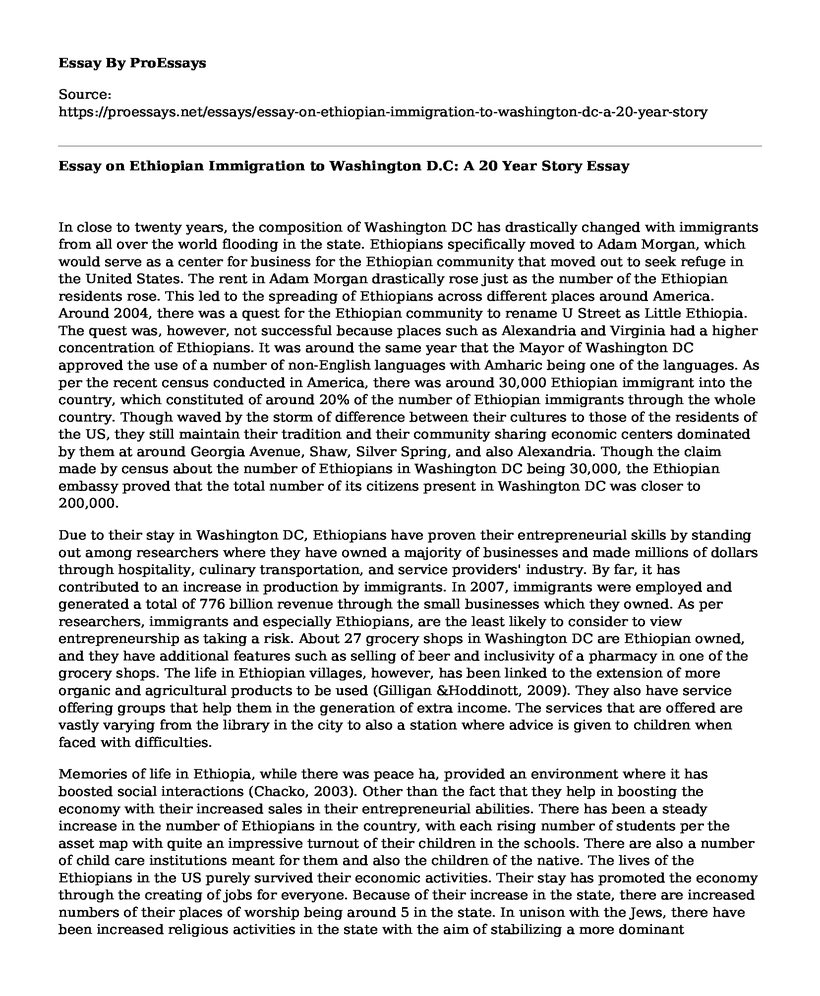In close to twenty years, the composition of Washington DC has drastically changed with immigrants from all over the world flooding in the state. Ethiopians specifically moved to Adam Morgan, which would serve as a center for business for the Ethiopian community that moved out to seek refuge in the United States. The rent in Adam Morgan drastically rose just as the number of the Ethiopian residents rose. This led to the spreading of Ethiopians across different places around America. Around 2004, there was a quest for the Ethiopian community to rename U Street as Little Ethiopia. The quest was, however, not successful because places such as Alexandria and Virginia had a higher concentration of Ethiopians. It was around the same year that the Mayor of Washington DC approved the use of a number of non-English languages with Amharic being one of the languages. As per the recent census conducted in America, there was around 30,000 Ethiopian immigrant into the country, which constituted of around 20% of the number of Ethiopian immigrants through the whole country. Though waved by the storm of difference between their cultures to those of the residents of the US, they still maintain their tradition and their community sharing economic centers dominated by them at around Georgia Avenue, Shaw, Silver Spring, and also Alexandria. Though the claim made by census about the number of Ethiopians in Washington DC being 30,000, the Ethiopian embassy proved that the total number of its citizens present in Washington DC was closer to 200,000.
Due to their stay in Washington DC, Ethiopians have proven their entrepreneurial skills by standing out among researchers where they have owned a majority of businesses and made millions of dollars through hospitality, culinary transportation, and service providers' industry. By far, it has contributed to an increase in production by immigrants. In 2007, immigrants were employed and generated a total of 776 billion revenue through the small businesses which they owned. As per researchers, immigrants and especially Ethiopians, are the least likely to consider to view entrepreneurship as taking a risk. About 27 grocery shops in Washington DC are Ethiopian owned, and they have additional features such as selling of beer and inclusivity of a pharmacy in one of the grocery shops. The life in Ethiopian villages, however, has been linked to the extension of more organic and agricultural products to be used (Gilligan &Hoddinott, 2009). They also have service offering groups that help them in the generation of extra income. The services that are offered are vastly varying from the library in the city to also a station where advice is given to children when faced with difficulties.
Memories of life in Ethiopia, while there was peace ha, provided an environment where it has boosted social interactions (Chacko, 2003). Other than the fact that they help in boosting the economy with their increased sales in their entrepreneurial abilities. There has been a steady increase in the number of Ethiopians in the country, with each rising number of students per the asset map with quite an impressive turnout of their children in the schools. There are also a number of child care institutions meant for them and also the children of the native. The lives of the Ethiopians in the US purely survived their economic activities. Their stay has promoted the economy through the creating of jobs for everyone. Because of their increase in the state, there are increased numbers of their places of worship being around 5 in the state. In unison with the Jews, there have been increased religious activities in the state with the aim of stabilizing a more dominant community. An Ethiopian Expo is usually held in Washington DC as part of the recreation of the Ethiopians.
References
Chacko, E. (2003). Identity and assimilation among young Ethiopian immigrants in metropolitan Washington. Geographical Review, 93(4), 491-506.
Dercon, S., Gilligan, D. O., Hoddinott, J., & Woldehanna, T. (2009). The impact of agricultural extension and roads on poverty and consumption growth in fifteen Ethiopian villages. American Journal of Agricultural Economics, 91(4), 1007-1021.
Cite this page
Essay on Ethiopian Immigration to Washington D.C: A 20 Year Story. (2023, Apr 09). Retrieved from https://proessays.net/essays/essay-on-ethiopian-immigration-to-washington-dc-a-20-year-story
If you are the original author of this essay and no longer wish to have it published on the ProEssays website, please click below to request its removal:
- Cyberbullying and College Students: What Can Be Done? Paper Example
- Essay on Police's Violation of Jack's Constitutional Rights
- Essay Sample on Exploring the Impact of US Federal Immigration Policies on Local Governments
- Essay Sample on CAPTA: Defining Child Abuse & Neglect to Receive Federal Funds
- Essay Sample on French Declaration of War on England Tests US Neutrality
- Immigration: A Key Element to US Success, But Divisive Too - Essay Sample
- Diverting Debate: The Pitfalls of Introducing False Assumptions - Essay Sample







